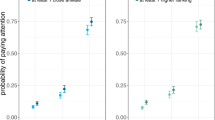Abstract
Responses to novel objects by pair-livingSaimiri andCallicebus and grouplivingSaimiri were investigated in two experiments. In the first, titis and squirrel monkeys were tested in the presence and absence of an opposite-sexed pairmate. The species were differentially affected by the absence of the pairmate: titis of both sexes were distressed and object interest was attenuated; squirrel monkeys were not distressed and object scores (particularly females') increased. Nonsocial differences in object exploration principally involved the tempo and mode of investigation; squirrel monkeys were quicker and more vigorous than titis.
In the second experiment, presence of a novel object was found to attract and arouse grouplivingSaimiri, as indicated by the change in the frequency and nature of social interactions and spatial distribution. Within- and between-sex social interactions reflected the typical female nucleus-peripheral male pattern seen inSaimiri groups in other environments. Species differences in investigatory patterns were considered to be contributing elements in the maintenance of distinctive life-styles.
Similar content being viewed by others
References
Baldwin, J. D., 1968. The social behavior of adult male squirrel monkeys in a seminatural environment.Folia primat., 9: 281–314.
————, 1971. The social organization of a semifree-ranging troop of squirrel monkeys (Saimiri sciureus).Folia primat., 14: 23–50.
———— &J. I. Baldwin, 1971. Squirrel monkeys in natural habitats in Panama, Colombia, Brazil, and Peru.Primates, 12: 45–61.
Clark, D. L. &J. E. Dillon, 1974. Social dominance relations between previously unacquainted male and female squirrel monkeys.Behaviour, 50: 217–231.
Coe, C. L. &L. A. Rosenblum, 1974. Sexual segregation and its ontogeny in squirrel monkey social structure.J. Hum. Evol., 3: 551–561.
Cubicciotti, D., III &W. A. Mason, 1975. Comparative studies of social behavior inCallicebus andSaimiri: Male-female emotional attachments.Behav. Biol., 16: 185–197.
Davis, R. T., R. W. Leary, M. D. C. Smith, &R. F. Thompson, 1968. Species differences in the gross behavior of nonhuman primates.Behaviour, 21: 326–338.
Glickman, S. E. &R. W. Sroges, 1966. Curiosity in zoo animals.Behaviour, 26: 151–188.
Haude, R. H. &O. S. Ray, 1974. Visual observing behavior in the squirrel monkey.Anim. Learn. Behav., 2: 138–140.
Mason, W. A., 1966. Social organization of the South American monkey,Callicebus moloch: A preliminary report.Tulane Studies in Zoology, 13: 23–28.
————, 1968. Use of space byCallicebus groups. In:Primates: Studies in Adaptation and Variability,P. C. Jay (ed.), Holt, Rinehart, & Winston, New York, pp. 200–216.
————, 1971. Field and laboratory studies of social organization inSaimiri andCallicebus. In:Primate Behavior,L. A. Rosenblum (ed.), Academic Press, New York, pp. 107–137.
————, 1974. Comparative studies of social behavior inCallicebus andSaimiri: Behavior of male-female pairs.Folia primat., 22: 1–8.
————, 1975. Comparative studies of social behavior inCallicebus andSaimiri: Strength and specificity of attraction between male-female cagemates.Folia primat., 23: 113–123.
———— &G. Epple, 1969. Social organization in experimental groups ofSaimiri andCallicebus.Proc. 2nd Int. Congr. Primat., 1: 59–65.
Menzel, E. W., Jr., 1966. Responsiveness to objects in free-ranging Japanese monkeys.Behaviour, 26: 130–150.
————, 1969. Naturalistic and experimental approaches to primate behavior. In:Naturalistic Viewpoints in Psychological Research,E. Willems &H. Raush (eds.), Holt, Rinehart, & Winston, New York, pp. 78–121.
————, 1971. Group behavior of chimpanzees: Responsiveness to cumulative novel changes in a large outdoor enclosure.J. comp. Physiol. Psychol., 74: 46–51.
Mode, E. B., 1961.Elements of Statistics. Prentice Hall, Englewood Cliffs, New Jersey.
Moynihan, M., 1966. Communication in the titi monkey,Callicebus. J. Zool., Lond., 150: 77–127.
Phillips, M. J. &W. A. Mason, 1976. Comparative studies of social behavior inCallicebus andSaimiri: Social looking in male-female pairs.Bull. Psychonom. Soc., 7: 55–56.
Ploog, D. &P. D. MacLean, 1963. Penile erection in squirrel monkeys.Anim. Behav., 11: 32–39.
————,J. Blitz, &F. Ploog, 1963. Studies on social and sexual behavior of the squirrel monkey (Saimiri sciureus).Folia primat., 1: 29–66.
Strayer, F. F., M. Taylor, &P. Yanciw, 1975. Group composition effects on social behavior of captive squirrel monkeys (Saimiri sciureus).Primates, 16: 253–260.
Thorington, R. W., 1968. Observations of squirrel monkeys in a Colombian forest. In:The Squirrel Monkey,L. A. Rosenblum &R. W. Cooper (eds.), Academic Press, New York, pp. 69–85.
Vaitl, E. A., W. A. Mason, D. M. Taub, & C. O. Anderson, in press. Contrasting effects of living in heterosexual pairs and mixed groups on the structure of social attraction of squirrel monkeys (Saimiri).Anim. Behav.
Author information
Authors and Affiliations
About this article
Cite this article
Fragaszy, D.M., Mason, W.A. Response to novelty inSaimiri andCallicebus: Influence of social context. Primates 19, 311–331 (1978). https://doi.org/10.1007/BF02382800
Received:
Accepted:
Issue Date:
DOI: https://doi.org/10.1007/BF02382800




